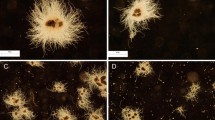Abstract
Mycelia of Morchella esculenta were found to aggregate rapidly in a submerged culture, which caused the decrease in dispersed mycelia and the problem of diffusion limitation. The effect of different agitation schemes on the growth of mycelia was investigated in a stirred-tank bioreactor. At the constant speed of 100 or 300 rpm, rapid aggregation caused the biomass concentration to drop to zero in 30 h, which was even worse than achieved under static culture. Intermittent agitation maintained a higher mycelium fragment concentration for 48 h and enhanced the biomass concentration to 4.73 g/L at 120 h. The operation with a polytron connection disrupted effectively mycelium aggregation, thus increasing the specific growth rate, biomass concentration and maximum productivity to 0.0613 1/h, 7.73 g/L and 0.0878 g/L h at 88 h, respectively. Moreover, logistic equations and genetic algorithm (GA) were used for the simulation of biomass growth and estimation of all kinetic coefficients. The operating strategy developed in this study could be used for the production of highly aggregated mycelia, which could also achieve a high cell-density culture in a stirred tank reactor.











Similar content being viewed by others
References
Li J, Wang Z, Yao LT, Jia L (2005) Advanced in Morchella esculenta polysaccharides studies. J Microbiol (in Chinese) 25(4):89–91
Xiong Y, Che ZM (2007) Present situation and prospect on liquid fermentation of Morchella esculenta. Food Res Dev (in Chinese) 128(1):165–168
Li XM, Zhao JP, Tang ZB (2004) A study on submerged culture of Morchella Conica. J Northwest For Univ (in Chinese) 19(3):116–118
Jia JH, Leu SL, Farn LC (2002) Studies on extraction, separation and purification of the submerged-fermentation Morchella polysaccharide. Food Sci (in Chinese) 23(4):59–63
Gang J, Lan LX, Liu CH (2008) Study on the liquid cultivation conditions of edible mushroom mycelia. Biotechnology (in Chinese) 18(4):67–69
Audet J, Gagnon H, Lounes M, Thibault J (1998) Polysaccharide production: experimental comparison of the performance of four mixing devices. Bioproc Eng 19(1):45–52
Rau U, Gura E, Olszewski E, Wanger F (1992) Enhanced glucan formation of filamentous fungi by mixing, oxygen limitation and fed-batch processing. J Ind Microbiol 9(1):19–25
Yang FC, Yang MJ (2005) Influence of agitation intensity on mycelium aggregation of Ganoderma lucidum. J Chin Inst Chem Eng 36(6):669–674
Gibbs PA, Seviour RJ, Schmid F (2000) Growth of filamentous fungi in submerged culture: problems and possible solutions. Crit Rev Biotechnol 20(1):17–48
Papagianni M (2004) Fungal morphology and metabolite production in submerged mycelial processes. Biotechnol Adv 22(3):189–259
Nielsen JC, Johansen L, Jacobsen M, Krabben P, Villadsen J (1995) Pellet formation and fragmentation in submerged cultures of Penicillium chrysogenum and its relation to penicillin production. Biotechnol Prog 11(1):93–98
Yang W, Hartwieg EA, Fang A, Demain AL (2003) Effect of carboxymethylcellulose and carboxypolymethylene on morphology of Aspergillus fumigatus NRRL2346 and fumagillin production. Curr Microbiol 46(1):24–27
Yang FC, Yang MJ, Cheng SH (2009) A novel method to enhance the mycelia production of Ganoderma lucidum in submerged cultures by polymer additives and agitation strategies. J Taiwan Inst Chem Eng 40(2):148–154
Xiao BY (2006) Effect of different agitation strategy on the mycelia growth of Morchella esculenta. MSc thesis, Department of Chemical Engineering, Tunghai University, Taiwan
Kimura S, Konagata A (2003) A genetic algorithm with distance independent diversity control for high dimensional function optimization. Trans Jpn Soc Artif Intel 18(4):193–202
Elmayergi H, Scharer JM, Moo-Young M (1973) Effect of polymer additives on fermentation parameters in a culture of Aspergillus niger. Biotechnol Bioeng 15(5):845–859
Byrne GS, Ward QP (1987) Effect of polymers on pelleting of Rhizopus arrhizus. Trans Br Mycol Soc 89(3):367–371
Jones P, Batool A, Trinci APJ, Moore D (1988) Effect of polymeric additives, especially, Junlon and Hostacerin, on growth of some basidiomycetes in submerged cultures. Trans Br Mycol Soc 90(4):577–583
Gerin PA, Dufrene Y, Bellon-Fontaine MN, Asther M, Rouxhet PG (1993) Surface properties of the conidiospores of Phanerochaete chrysosporium and their relevance to pellet formation. J Bacteriol 175(16):5135–5144
Author information
Authors and Affiliations
Corresponding author
Rights and permissions
About this article
Cite this article
Ma, TW., Xiao, BY. & Yang, FC. Establishment of cultivating strategy for highly aggregated mycelia of Morchella esculenta in a stirred-tank bioreactor. Bioprocess Biosyst Eng 35, 1627–1635 (2012). https://doi.org/10.1007/s00449-012-0753-x
Received:
Accepted:
Published:
Issue Date:
DOI: https://doi.org/10.1007/s00449-012-0753-x




